
Izumi Sugita
(Scholarly and Academic Information Division, NII)
● Introduction
In the fall of 2010, I had the opportunity to attend open access-related events in three East Asian capitals: the SPARC Japan Seminar “Open Access Disseminated from Japan,”1 which I helped to organize and moderated, in Tokyo; the Open Access Korea (OAK) Conference2 in Seoul, and the Berlin8,3 which took place in Beijing. On the whole, the speakers tended to emphasize business models and policy aspects rather than the technical side. This report will focus in particular on the debate surrounding open access (OA) journals.
● 6th SPARC Japan Seminar, “Open Access Disseminated from Japan,” in Tokyo
(October 20)
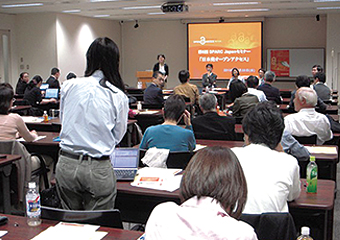
Figure 1: Discussion at the SPARC Japan Seminar
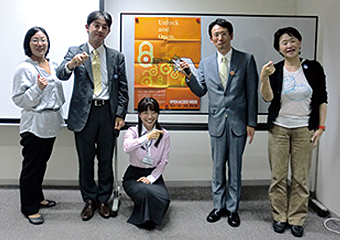
Figure 2: The speakers, moderator, and facilitator do the “Unlock and Open” pose.
The week of October 18–24 was “Open Access Week” (OAW), a global event declared by SPARC in the USA. Nearly 900 people in 94 countries reportedly took part in various OA-related activities.
The topic of the SPARC Japan Seminar was “Open Access Disseminated from Japan.” A set of guidelines issued by the Japanese government’s Council for Science and Technology Policy4 in June 2010 called for “promotion of institutional repositories and open access” and noted “the need for researchers to release the outline and results of their studies in an easy-to-understand manner.” The seminar accordingly set out to consider what can be done in concrete terms to ensure that these recognitions receive more than lip service (Figure 1).
In his presentation “Prospects for the Open Access Publishing Model Based on Trends of E-journals in Japan,” Mr. Kazuhiro Hayashi of the Chemical Society of Japan and the SPARC Japan Steering Committee outlined the state of OA in Japan and gave concrete examples.5 He pointed out that circumstances are favorable for many Japanese journals to become OA as they already provide free access, while noting that various issues need to be resolved, especially in the area of quality, and that researchers are the key to this.
Associate Prof. Yuko Murakami of Tohoku University, in “Collaboration between University Libraries and Academic Associations: A Case Study of the Japan Association for Contemporary and Applied Philosophy,” spoke as one of the researchers who founded the peer-reviewed e-journal Contemporary and Applied Philosophy6 with the support of KURENAI, the institutional repository of Kyoto University, where the association that publishes the journal is based. She shared her experiences of practical matters such as what a small society needs to set out to publish an OA journal and where the costs arise.
“New Web Content in Japanese: ‘Life Science – Review of New Articles,’”7 the presentation by Mr. Keisuke Iida of the Database Center for Life Science, introduced a service which publishes reviews of articles whose lead author is Japanese soon after they appear in prestigious journals such as Cell, Nature, and Science; the author of the original paper writes a review in Japanese and releases it online, free of charge, as soon as possible. Although not, strictly speaking, a case of OA, Mr. Iida was asked to talk about this as an example of an initiative that anticipates the guidelines mentioned above. He noted the importance of editing to make the reviews readily comprehensible to the target readers, who are life science researchers with different specialties—a point which I think is well taken in publishing of every kind. The service was just launched in September, but over 60 percent of the researchers asked to write reviews have cooperated, and the rate of uploads should reach over 100 per year. The secret of its success seems to be that the concept is a good fit for Japanese researchers’ needs in regard to making their results accessible.
Even if a journal is published online only, obviously it still costs money to publish. In the general discussion, facilitated by Ms. Yuko Nagai of the Zoological Society of Japan and the SPARC Japan Steering Committee, there was a lively exchange of detailed comments from diverse viewpoints about who should pay for what, when, and in what capacity. I was made newly aware that the optimal solution differs from one research community to another, depending on its size, field, history, and composition, and that there is a need for a forum for the ongoing exchange of views and practical assistance (Figure 2).
The presentation materials and English abstracts are available on the SPARC Japan website. For a more detailed account (in Japanese), including the discussion, please see the blog “Katatsumuri wa denshi toshokan no yume o miru ka?” (Do snails dream of digital libraries?).8
● 2010 Open Access Korea (OAK) Conference in Seoul (October 22)
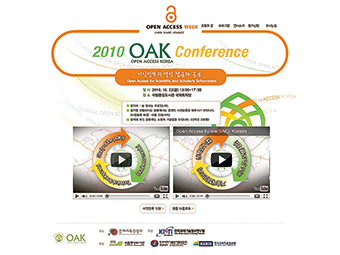
Figure 3: The OAK Conference website
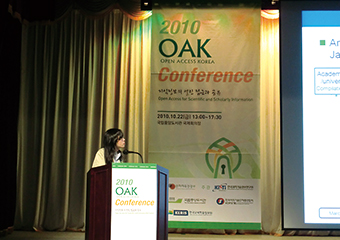
Figure 4: Prof. Takeda speaking at OAK
This was held at the National Library of Korea as part of OAW, with over 200 people in attendance (Figure 3).
OAK9 is an initiative for OA promotion spearheaded by the Korea Institute of Science and Technology Information (KISTI) with the cooperation of related bodies. KISTI provides a platform for OA journals.
An older OA-related project in Korea is the promotion of institutional repositories (IRs) by the Korea Education and Research Information Service (KERIS). Software known as dCollection is provided free, and nearly all of Korea’s approximately 200 universities are either building their own IRs or using KERIS’s hosting service. The project’s main goal is making degree theses accessible; reportedly, some 800,000 of these had been deposited as of January 2010. Meanwhile, there seems to have been less progress in self-archiving of academic articles (the “green” road to OA), as OAK favors the “gold” road of publication in OA journals. According to the organizers, the OAK Conference was the first initiative to share Korea’s OA activities broadly with the rest of the world.
The program opened with a keynote lecture on OA strategies by Dr. Choi Hee-Yoon, Director General of KISTI’s Knowledge Information Center. Next, Dr. Ralf Schimmer of the Max Planck Digital Library and Prof. Hideaki Takeda of NII (Figure 4) reported from Germany and Japan, respectively. Lastly, Dr. Seo Jeong-Wook, Director of the Seoul University Medical Library, spoke on OA in the medical field, and legal expert Kim Borami discussed global OA trends and the possibility of institutionalizing OA in Korea.
The situation in Korea resembles that in Japan in that its academic societies and other publishers produce journals in both Korean and English, and its researchers are strongly oriented toward international journals, to name just two of the many similarities. The goal for 2010 is for the societies that have joined KISTI’s OAK project to publish ten OA journals, and I will follow future developments with interest.
For details of OAK, see also the presentation by Ms. Hwang Hyekyong at Berlin810.
● Berlin8 Open Access Conference in Beijing (October 25–26)
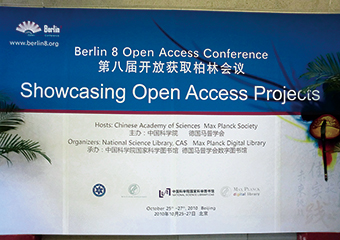
Figure 5: The Berlin8 venue on opening day
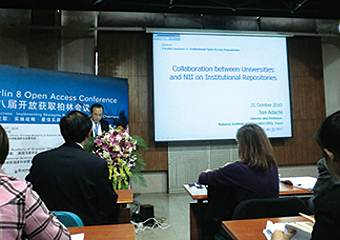
Figure 6: Prof. Adachi speaking at Berlin8
The National Science Library at the Chinese Academy of Sciences was the venue for “Berlin8,” the latest in a series of annual international follow-up meetings on the implementation of the recommendations in the “Berlin Declaration on Open Access to Knowledge in the Sciences and Humanities” (October 2003) (Figure 5). The first in the series to be held outside Europe, the conference drew a total of about 280 people: about 100 overseas delegates from over 50 institutions in 16 nations, and 180 Chinese delegates from over 100 research and teaching institutions and libraries.
Four people attended from Japan, and Prof. Jun Adachi of NII (Figure 6) and Ms. Seiko Tokuda of the University of Tsukuba and the Digital Repository Federation (DRF) were speakers in two sessions on “Institutional Open Access Repositories.” As Prof. Adachi discussed the challenges facing Japanese universities in his presentation, “Collaboration between Universities and NII on Institutional Repositories,” he raised three topical issues: the e-journal price spiral and the launching of a new consortium; institutional repositories as a safety net, and the need for researchers’ involvement; and the state of studies toward the institutionalization of OA.
The other sessions were: “National Open Access Strategies/Policies,” “Open Access Publishing,” “Supporting Infrastructure and Services for Sustainable OA,” “Legal Issues and Business Models in OA,” “Open Access in the World,” and “Open Data and Open Educational Resources.” All presentation materials are available at the Berlin8 website. Ms. Tokuda has also posted reports in Japanese to the DRF mailing list11 and DRF Monthly.12
Here, I would like to report in detail on two particularly memorable presentations: those of Dr. Oya Rieger of Cornell University on arXiv, and Dr. Salvatore Mele of CERN on SCOAP3.
arXiv13 began as a physics preprint server, established in 1991 by Paul Ginsparg of the Los Alamos National Laboratory. In 2001 it moved to Cornell University, and since 2006, hosted by the Cornell University Library, this information exchange tool has become indispensable in physics, mathematics, statistics, computer science and related fields as an integrated global resource. The impact of the recession made a new approach to funding arXiv necessary, and after study of the best cost recovery model, it was proposed in 2009 to have the user community (contributors and readers) play a role in funding. The model for 2010–2012 is to request contributions from the top 200 libraries and research institutes based on their download statistics; in 2010, contributions were secured from 85 institutions. NII is the intermediary for negotiations in Japan, and has secured the support of Nagoya University and nine others out of the fifteen Japanese institutions in the target group. In developing mid- to long-term business models for 2013 and beyond, said Dr. Rieger, as they address sustainability they “need to factor in a range of issues: user needs and scholarly communication culture; discovery and access; submission, moderation, quality control; and interoperability with related systems.” I had the impression that, as the communities it serves gradually diversify beyond physics, the arXiv model, which is clearly distinct from the traditional submission-review-publication process, is likely to fuel change in the nature of scholarly communications in the future.
The Sponsoring Consortium for Open Access in Particle Physics Publishing (SCOAP3)14 is an innovative OA journal business model that aims to convert peer-reviewed high-energy physics (HEP) literature to OA by redirecting funds that are currently used for journal subscriptions to pay centrally for editorial services and OA costs, thereby creating more value than the subscription model. It is presently a global partnership project involving libraries and library consortia in 24 countries, and 71 percent of the total budget envelope has been pledged by institutions worldwide. In the SCOAP3 business model, the basis for distributing costs among countries is not usage (as in arXiv), but the distribution of HEP articles published per country. Japan’s High Energy Accelerator Research Organization (KEK) announced its strong support for the spirit of SCOAP3 in August 2010. Participation in Asian countries had been lagging, but discussions are reportedly proceeding apace in China (whose share of costs is calculated at 5.6 percent) and India (2.7 percent).
● Conclusion
In my tour of these OA events, I gained a real sense that the open access movement, which began in the United States and Europe, is becoming a groundswell in Asia, especially China and Korea. The highlight was the energy displayed by people thinking and taking action themselves, rather than waiting for someone to solve the momentous question of the sustainability of scholarly communications or the vexed issue of escalating e-journal prices.
I came away with renewed resolve to continue our efforts toward solving these problems, making the most of the partnerships that SPARC Japan has developed with academic societies and the framework created by the new agreement between JANUL/PULC and NII (see topics 1 of this issue).
Online References
| 1. |
6th SPARC Japan Seminar 2010. “Open Access Disseminated from Japan,” www.nii.ac.jp/sparc/en/event/2010/20101020en.html |
| 2. |
2010 Open Access Korea (OAK) Conference. http://www.openaccessweek.org/events/2010-open-access-koreaoak |
| 3. |
Berlin8 Open Access Conference. http://www.berlin8.org/ |
| 4. |
Council for Science and Technology Policy. “Kagaku gijutsu kihon seisaku sakutei no kihon hōshin” (Guidelines for Science and Technology Basic Policy Planning) (June 2010). http://www8.cao.go.jp/cstp/siryo/haihu91/haihu-si91.html |
| 5. |
Kazuhiro, Hayashi. “Potential Japanese Approaches to Open Access Publishing: Open Access from the Perspective of Academic Societies.” SPARC Japan Newsletter no. 6. (Aug. 2010) http://www.nii.ac.jp/sparc/publications/newsletter/pdfper/6/sj-NewsLetter-6-2.pdf |
| 6. |
Contemporary and Applied Philosophy. http://openjournals.kulib.kyoto-u.ac.jp/ojs/index.php/cap/index |
| 7. |
“Raifu saiensu shinchaku ronbun rebyū” (Life Science – Review of New Articles). “First Author’s”. http://first.lifesciencedb.jp/ |
| 8. |
“Katatsumuri wa denshi toshokan no yume o miru ka” (Do snails dream of digital libraries?).
http://d.hatena.ne.jp/min2-fly/20101022/1287707520 |
| 9. |
OAK Repository. http://repository.oak.go.kr/ |
| 10. |
Berlin8 program and presentation materials. http://www.berlin8.org/?view=content/article&id=13&miid=9 |
| 11. |
“[drf:2108] Berlin8 sanka hōkoku” (Report on participation in Berlin8). http://drf.lib.hokudai.ac.jp/drfml/msg02096.html
“[drf:2127] Re: Berlin8 sanka hōkoku” (Re: Report on participation in Berlin8). http://drf.lib.hokudai.ac.jp/drfml/msg02115.html |
| 12. |
“Sokuhō: Daihakkai Berurin Sengen Kinen Ōpun Akusesu Kaigi” (Bulletin: 8th Berlin Declaration Open Access Conference). Gekkan DRF (DRF Monthly) no. 9 (October 2010).
http://drf.lib.hokudai.ac.jp/drf/index.php?plugin=attach&refer=%E6%9C%88%E5%88%8ADRF&openfile=DRFmonthly_9.pdf |
| 13. |
arXiv. http://arXiv.org |
| 14. |
SCOAP3. http://scoap3.org/ |
|

